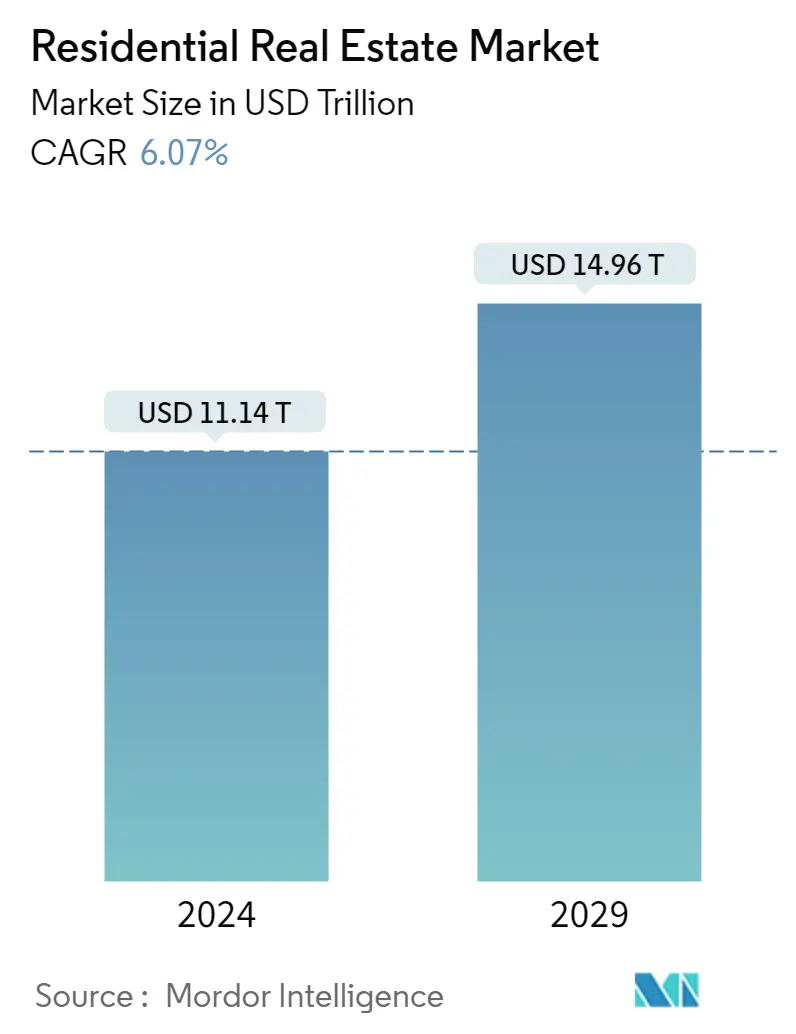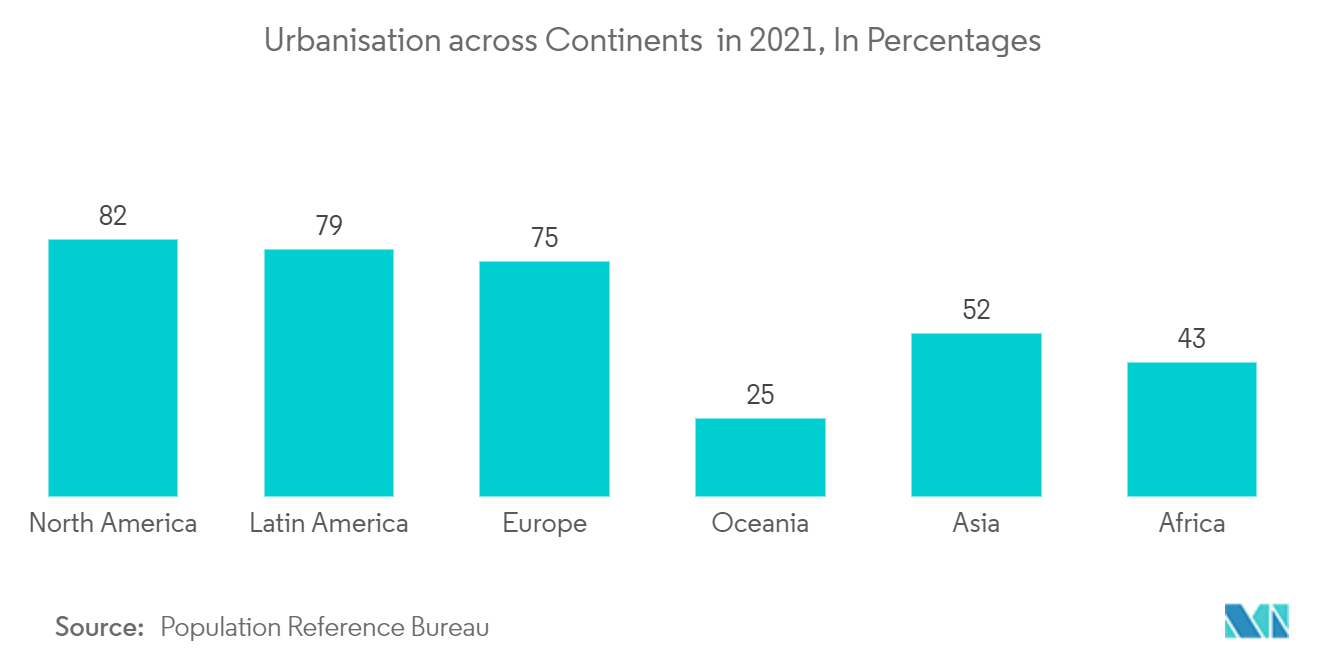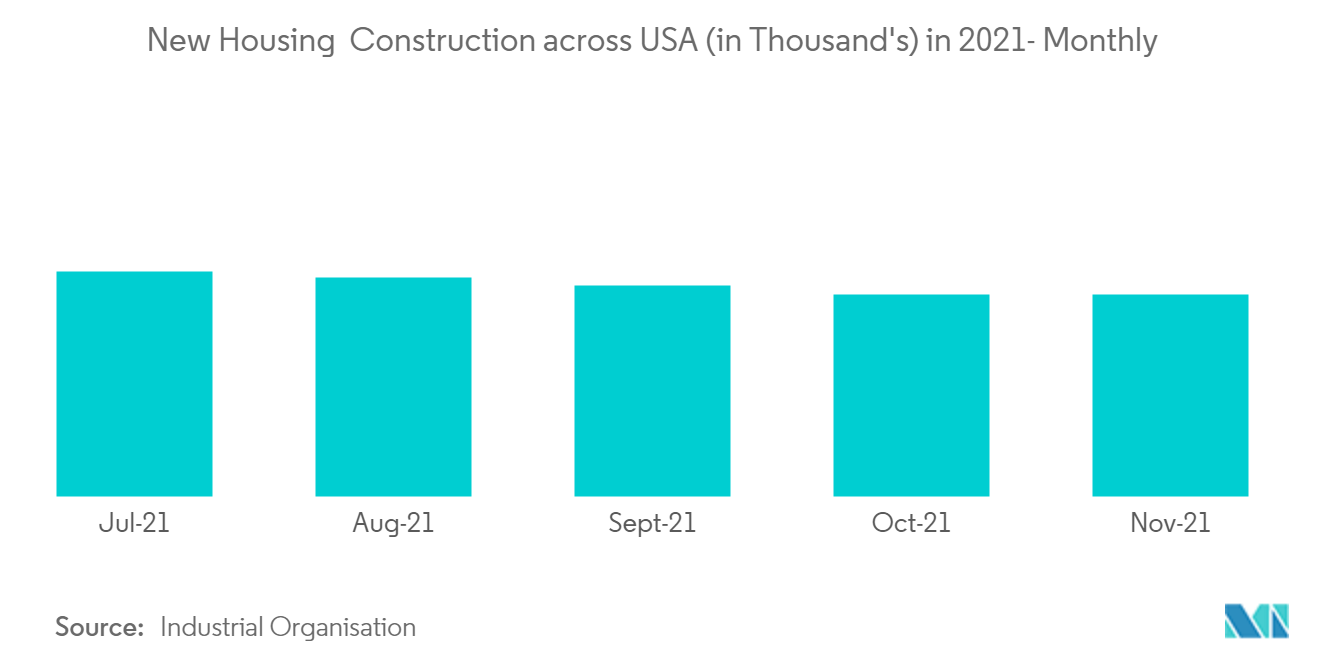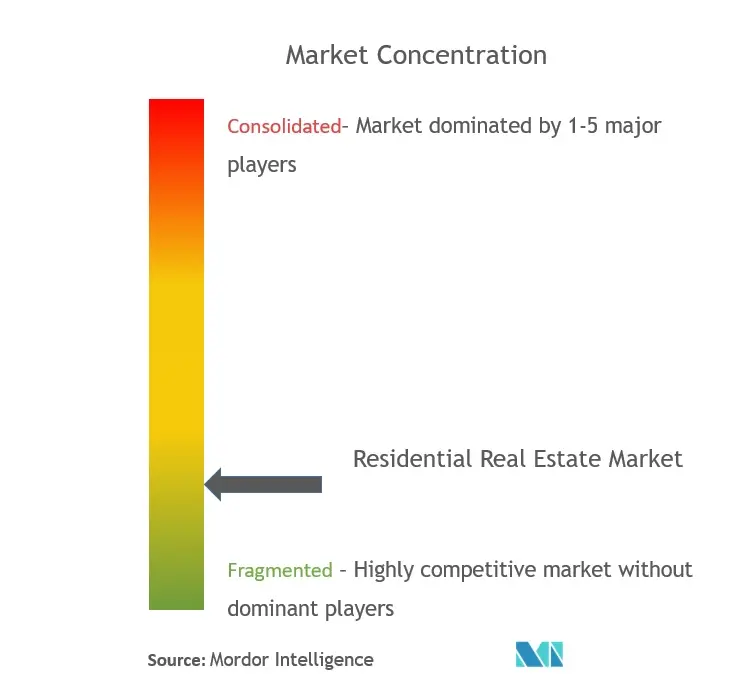Residential Real Estate Market Size

| Study Period | 2019 - 2028 |
| Market Size (2023) | USD 10.5 Trillion |
| Market Size (2028) | USD 14.10 Trillion |
| CAGR (2023 - 2028) | 6.07 % |
| Fastest Growing Market | Asia-Pacific |
| Largest Market | Asia-Pacific |
Major Players
*Disclaimer: Major Players sorted in no particular order |
Need a report that reflects how COVID-19 has impacted this market and its growth?
Residential Real Estate Market Analysis
The Residential Real Estate Market size is expected to grow from USD 10.50 trillion in 2023 to USD 14.10 trillion by 2028, at a CAGR of 6.07% during the forecast period (2023-2028).
The residential real estate (RRE) markets were impacted by the COVID-19 pandemic in several ways. On the one hand, lockdowns and the increased use of remote working practices are expected to increase the demand for RRE, and accommodative monetary policies are anticipated to improve its affordability. The economic downturn and increases in unemployment are expected to weigh negatively on demand. Due to lockdowns, most of the construction activity and property transactions came to a halt during the pandemic. In 2021, as soon as the lockdown relaxation took place, the residential real estate market surged.
The residential real estate market is the cornerstone of the well-being of any economy. Shelter is considered a basic need for humans and lies at the base of the famous hierarchy of needs pyramid (Maslow). Therefore, it is understood that the manner in which the residential real estate market moves has a rippling effect on people around the world.
Residential properties such as apartments, bungalows, and villas are bought and sold on the market. The residential real estate market in emerging nations is mostly driven by urbanization. Major cities in emerging nations such as India, China, Brazil, Argentina, and South Africa are fast expanding and require additional housing to accommodate people migrating from various regions of the country.
Furthermore, government measures promoting affordable housing stimulate market expansion. For example, governments in Australia, the United States, and Canada have planned strategies such as concessions for first-time buyers, veterans' subsidies, a golden visa, low-cost affordable housing schemes, and a reduction in transactional taxes, all of which are expected to boost growth in the residential real estate market. Even the low mortgage interest rates are fueling the residential real estate market in countries like the United States, Canada, India, and Australia.
Residential Real Estate Market Trends
This section covers the major market trends shaping the Residential Real Estate Market according to our research experts:
Growth of Urbanization is Propelling the Residential Real Estate Market
Today, around 55% of the world’s population, i.e., 4.2 billion inhabitants, live in cities. This trend is expected to continue. By 2050, with the urban population more than doubling its current size, nearly 7 of 10 people in the world will live in cities.
Most of this urbanization occurs in the developing world in cities such as Lagos, Bangalore, Beijing, and many other Asian, African, and Latin American cities. India, China, and Nigeria are expected to account for 35% of the global urban population during this projected growth.
With more than 80% of the global GDP generated in cities, urbanization can contribute to sustainable growth if managed well by increasing productivity and allowing innovation and new ideas to emerge. However, the speed and scale of urbanization accelerate the demand for affordable housing.
In recent years in Australia, there has been substantially more land released for low-density in growth corridors of major cities. As a result, there has been an uptick in first-home buyers. There is a shift to a shared urban lifestyle in apartments, with 30% of Sydney homes being apartments.
Since there is a growth of Tier 2 and Tier 3 cities across Asian countries like India, China, etc., there has been a huge surge in housing demands. Urbanization in these countries is driving residential real estate.

Increase in Residential Properties across the United States due to Less Mortgage Rates
The lending mortgage rates also affect the residential real estate market through the cost of financing a home purchase. Most Americans take out a mortgage to purchase a home, and mortgage debt accounts for about 70% of all household debts. The Federal Reserve's aggressive interest rate reduction and quantitative easing drove down treasury yields, lowering mortgage rates.
Industry experts claim the current residential boom emerged from a mix of low-interest rates, booming demand, and supply bottlenecks. It is a situation that many are feeling acutely about with no single policy to blame and no easy fix.
Banks lent an estimated USD 1.61 trillion for home purchases in 2021, up by 9% from 2020. During the pandemic, the housing market strengthened as many Americans transitioned to working at home, which put additional living space at a premium. Steady job growth, a stock market at all-time highs, rising rents, and expectations of higher mortgage rates have also spurred homebuyers.
The meager mortgage rates that have helped intensify housing market demand are expected to continue to grow higher in 2022. Thus, this is driving the residential real estate market.

Residential Real Estate Industry Overview
The residential real estate market is highly competitive, with the presence of regional and international players. International MNCs include Savills PLC and Sun Hung Kai Properties. The regional players are dominant in their respective countries, like DLF in India and KB Homes in the United States. Major companies in the market have adopted strategies such as acquisitions, business developments, joint ventures, partnerships, and product launches to offer better services to customers in the residential real estate market. For instance, in 2021, Savills formed a strategic alliance with SRS Real Estate Partners. In 2021, Lennar Group acquired RealStar Homes, a privately-held Coastal Carolinas operator, to expand in the market.
Residential Real Estate Market Leaders
Christie International Real Estate
ColdWell Banker Real estate Company
Al Habtoor Group
DLF Ltd
Hochtief Corporation
*Disclaimer: Major Players sorted in no particular order

Residential Real Estate Market News
In January 2022, Pulte Homes announced its newest community for the Seattle market, Arborwood. Bordering North Kitsap Heritage Park and in close proximity to the White Horse Golf Club, Arborwood is a new construction community located in Kingston on the Olympic Peninsula. With the first phase of the community expected to open in spring 2022, Arborwood will feature 410 single-family homes at buildout and introduce several new floor plans to the market.
In October 2021, Lennar, one of the leading US homebuilders, and ICON, a construction technology company pioneering large-scale 3D printing, announced a commitment to build the largest community of 3D-printed homes to date using ICON's innovative robotics, software, and advanced materials. Breaking ground in 2022, the 100-home community will be co-designed by the acclaimed architecture firm BIG-Bjarke Ingels Group. The announcement deepens a relationship that began with Lennar's investment in Austin-based ICON's recent USD 207-million financing round and offers a promising path toward delivering affordable, technology-driven homes that meet the rising demand.
Residential Real Estate Market Report - Table of Contents
1. INTRODUCTION
1.1 Study Assumptions
1.2 Scope of the Study
2. RESEARCH METHODOLOGY
2.1 Analysis Methodology
2.2 Research Phases
3. EXECUTIVE SUMMARY
4. MARKET INSIGHTS
4.1 Current Market Scenario
4.2 Residential Real Estate Buying Trends - Socioeconomic and Demographic Insights
4.3 Government Initiatives and Regulatory Aspects Pertaining to the Residential Real Estate Sector
4.4 Insights into the Size of Real Estate Lending and Loan-to-value Trends
4.5 Insights into the Interest Rates for the General Economy and Real Estate Lending
4.6 Insights into the Rental Yields in the Residential Real Estate Sector
4.7 Insights into the Capital Market Penetration and REIT Presence in the Residential Real Estate Sector
4.8 Insights into the Support Provided by the Government and Public-private Partnerships for Affordable Housing
4.9 Insights into the Tech and Startups Active in the Real Estate Sector (Broking, Social Media, Facility Management, and Property Management)
4.10 Impact of COVID-19 on the Market
5. MARKET DYNAMICS
5.1 Drivers
5.2 Restraints
5.3 Opportunities
5.4 Porter's Five Forces Analysis
5.4.1 Bargaining Power of Suppliers
5.4.2 Bargaining Power of Buyers
5.4.3 Threat of New Entrants
5.4.4 Threat of Substitute Products
5.4.5 Intensity of Competitive Rivalry
6. MARKET SEGMENTATION
6.1 Type
6.1.1 Apartments and Condominiums
6.1.2 Landed Houses and Villas
6.2 Geography
6.2.1 North America
6.2.1.1 United States
6.2.1.2 Canada
6.2.2 Europe
6.2.2.1 United Kingdom
6.2.2.2 France
6.2.2.3 Germany
6.2.2.4 Rest of Europe
6.2.3 Asia-Pacific
6.2.3.1 China
6.2.3.2 India
6.2.3.3 Japan
6.2.3.4 South Korea
6.2.3.5 Australia
6.2.3.6 Rest of Asia-Pacific
6.2.4 Middle East & Africa
6.2.4.1 United Arab Emirates
6.2.4.2 Saudi Arabia
6.2.4.3 South Africa
6.2.4.4 Rest of Middle East & Africa
6.2.5 Latin America
6.2.5.1 Brazil
6.2.5.2 Argentina
6.2.6 Rest of the World
7. COMPETITIVE LANDSCAPE
7.1 Market Concentration Overpower
7.2 Company Profiles
7.2.1 Christie International Real Estate
7.2.2 ColdWell Banker Real Estate Company
7.2.3 Al Habtoor Group
7.2.4 DLF Ltd
7.2.5 Hochtief Corporation
7.2.6 IJM Corporation Berhad
7.2.7 Engel & Volkers AG
7.2.8 Lennar Corporation
7.2.9 Raubex Group Ltd
7.2.10 Pultegroup Inc.
7.2.11 Dr Hortons
7.2.12 Savills PLC
7.2.13 Sotheby International Realty Affiliates LLC
7.2.14 Sun Hung Kai Properties Ltd*
- *List Not Exhaustive
8. MARKET OPPORTUNITIES AND FUTURE TRENDS
9. APPENDIX
9.1 Macroeconomic Indicators (GDP Breakdown by Sector, Contribution of Construction to Economy, etc.)
9.2 Key Production, Consumption, and Export and Import Statistics of Construction Materials
Residential Real Estate Industry Segmentation
Residential real estate is an area developed for people to live. As defined by local zoning ordinances, residential real estate cannot be used for commercial or industrial purposes.
The report includes a thorough background analysis of the residential real estate market, including an assessment of the economy and the contribution of sectors to the economy, a market overview, government initiatives, insights into various residential real estate trends, market dynamics, and geographical trends.
The residential real estate market is segmented by type (apartments and condominiums and landed houses and villas) and geography (North America, Europe, Asia-Pacific, Middle East & Africa, Latin America, and Rest of the World). The report offers the market sizes and forecasts in value (USD billion) for all the above segments.
| Type | |
| Apartments and Condominiums | |
| Landed Houses and Villas |
| Geography | ||||||||
| ||||||||
| ||||||||
| ||||||||
| ||||||||
| ||||||||
| Rest of the World |
Residential Real Estate Market Research FAQs
How big is the Residential Real Estate Market?
The Residential Real Estate Market size is expected to reach USD 10,501.65 billion in 2023 and grow at a CAGR of 6.07% to reach USD 14,100.04 billion by 2028.
What is the current Residential Real Estate Market size?
In 2023, the Residential Real Estate Market size is expected to reach USD 10,501.65 billion.
Who are the key players in Residential Real Estate Market?
Christie International Real Estate, ColdWell Banker Real estate Company, Al Habtoor Group, DLF Ltd and Hochtief Corporation are the major companies operating in the Residential Real Estate Market.
Which is the fastest growing region in Residential Real Estate Market?
Asia-Pacific is estimated to grow at the highest CAGR over the forecast period (2023-2028).
Which region has the biggest share in Residential Real Estate Market?
In 2023, the Asia-Pacific accounts for the largest market share in the Residential Real Estate Market.
Residential Real Estate Industry Report
Statistics for the 2023 Residential Real Estate market share, size and revenue growth rate, created by Mordor Intelligence™ Industry Reports. Residential Real Estate analysis includes a market forecast outlook to 2028 and historical overview. Get a sample of this industry analysis as a free report PDF download.
